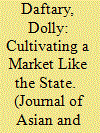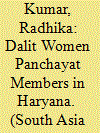| Srl | Item |
| 1 |
ID:
175103


|
|
|
|
|
| Summary/Abstract |
Global policy organizations, financial institutions, and national governments have emphasized high-value agriculture in the world’s semi-arid areas inhabited by the greatest proportion of its poor, stressing linking households to markets to improve their well-being. This is assumed to involve state withdrawal and the ascendance of self-evident market forces. By means of ethnographic fieldwork in semi-arid western India, this paper discusses how the market does not arise spontaneously, but is deepened through state intensification. Rural households are imbricated with new markets by the state’s rendering of development policy market-driven, and through democratic decentralization, which has emerged as an instrument to facilitate the penetration of market actors into remote rural communities.
|
|
|
|
|
|
|
|
|
|
|
|
|
|
|
|
| 2 |
ID:
178426


|
|
|
|
|
| Summary/Abstract |
Drawing on the latest round of elections to Panchayati Raj Institutions in the state of Haryana in 2016, this article interrogates the substantial increase in the number of Dalit women representatives, based on fieldwork in a specific village. Since both Dalit and non-Dalit women present narratives of non-participation in the functioning of the village panchayat, it is argued that the increase in Dalit women representatives was not by design, but by default, due to an amendment of the Haryana Panchayati Raj Act 2015. Overall, in the studied village, women continue to remain marginalised in the local representative bodies, and gender-based quotas have only ensured numerical visibility of women.
|
|
|
|
|
|
|
|
|
|
|
|
|
|
|
|
| 3 |
ID:
163585


|
|
|
|
|
| Summary/Abstract |
Rural employment generation was initiated in India through the National Rural Employment Guarantee Act (NREGA) in 2005 and related NREGS schemes, to provide better social and food security to socially and economically depressed rural workers. By now, the implementation of this scheme is known to be not equally satisfactory throughout India, with significant variations in different states and localities. This article, based on intensive fieldwork over 1 year in remote villages of Deogarh and Bhim blocks of Rajasamand district, explores the functioning of the scheme in rural Rajasthan. It identifies three important roadblocks to effective NREGA implementation and analyses their impact: persistence of caste-based inequalities and social interactions among different groups of rural people, differential occupational interests of potential workers and lack of initiative of the respective panchayats.
|
|
|
|
|
|
|
|
|
|
|
|
|
|
|
|